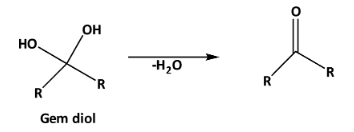
Which of the following gem diols is stable?
A. \[\;C{H_3} - C{\left( {OH} \right)_2} - H\]
B. \[\;CB{r_3} - C{\left( {OH} \right)_2} - H\]
C. \[\;C{F_3} - C{\left( {OH} \right)_2} - H\]
D. \[\;{C_6}{H_5} - C{\left( {OH} \right)_2} - {C_6}{H_5}\]
Answer
132.3k+ views
Hint: Alcohol is an organic compound in which the hydroxyl group is bound with a saturated carbon atom. Primary alcohol(ethanol) is used as a drug. Based on the number of \[ - OH\] groups there are two kinds of alcohol, one is gem diol and the other one is a vicinal diol.
Complete step by step answer:
When the two \[ - OH\] groups are attached at the same carbon of the organic compound then it is called gem diol. And when the \[ - OH\] groups are in two different but neighboring carbon then it is called vicinal diol.
The gem diols are less stable than vicinal diols
The stability of gem diols can be increased in the presence of the electron-withdrawing group at the alpha position. +I effect decreases the stability of the gem diol and increases the extent of dehydration as follows.

And -I effect increases the stability of gem diol. As well as the intramolecular hydrogen bonding also increases the stability of gem diol.
In the case of \[\;C{H_3} - C{\left( {OH} \right)_2} - H\] the methyl group shows the positive inductive effect, as a result, the stability decreases, and dehydration of this gem diol takes place.
In the case of \[\;{C_6}{H_5} - C{\left( {OH} \right)_2} - {C_6}{H_5}\] the two phenyl groups show a positive resonance effect, as a result, the stability decreases, and dehydration of this gem diol takes place.
In the case of \[\;CB{r_3} - C{\left( {OH} \right)_2} - H\] the electronegativity of bromine is less, as a result, the stability decreases, and dehydration of this gem diol takes place.
But in case of \[\;C{F_3} - C{\left( {OH} \right)_2} - H\] due to the highest electronegativity of fluorine this gem diol is stable.
Therefore, considering the stability factor of gem diol the most stable gem diol is \[\;C{F_3} - C{\left( {OH} \right)_2} - H\].
The correct answer is C.
Note: The vicinal diols can be formed by oxidation of the double bonds. For example, when acidified \[\;KMn{O_4}\] reacts with cyclohexene oxidation of the double bonds takes place and vicinal diol is formed as follows,

Complete step by step answer:
When the two \[ - OH\] groups are attached at the same carbon of the organic compound then it is called gem diol. And when the \[ - OH\] groups are in two different but neighboring carbon then it is called vicinal diol.
The gem diols are less stable than vicinal diols
The stability of gem diols can be increased in the presence of the electron-withdrawing group at the alpha position. +I effect decreases the stability of the gem diol and increases the extent of dehydration as follows.

And -I effect increases the stability of gem diol. As well as the intramolecular hydrogen bonding also increases the stability of gem diol.
In the case of \[\;C{H_3} - C{\left( {OH} \right)_2} - H\] the methyl group shows the positive inductive effect, as a result, the stability decreases, and dehydration of this gem diol takes place.
In the case of \[\;{C_6}{H_5} - C{\left( {OH} \right)_2} - {C_6}{H_5}\] the two phenyl groups show a positive resonance effect, as a result, the stability decreases, and dehydration of this gem diol takes place.
In the case of \[\;CB{r_3} - C{\left( {OH} \right)_2} - H\] the electronegativity of bromine is less, as a result, the stability decreases, and dehydration of this gem diol takes place.
But in case of \[\;C{F_3} - C{\left( {OH} \right)_2} - H\] due to the highest electronegativity of fluorine this gem diol is stable.
Therefore, considering the stability factor of gem diol the most stable gem diol is \[\;C{F_3} - C{\left( {OH} \right)_2} - H\].
The correct answer is C.
Note: The vicinal diols can be formed by oxidation of the double bonds. For example, when acidified \[\;KMn{O_4}\] reacts with cyclohexene oxidation of the double bonds takes place and vicinal diol is formed as follows,

Recently Updated Pages
Sign up for JEE Main 2025 Live Classes - Vedantu

JEE Main Books 2023-24: Best JEE Main Books for Physics, Chemistry and Maths

JEE Main 2023 April 13 Shift 1 Question Paper with Answer Key

JEE Main 2023 April 11 Shift 2 Question Paper with Answer Key

JEE Main 2023 April 10 Shift 2 Question Paper with Answer Key

JEE Main 2023 (April 6th Shift 2) Chemistry Question Paper with Answer Key

Trending doubts
JEE Main 2025 Session 2: Application Form (Out), Exam Dates (Released), Eligibility & More

Degree of Dissociation and Its Formula With Solved Example for JEE

JEE Main 2025: Derivation of Equation of Trajectory in Physics

Convert chloro benzene to phenol class 12 chemistry JEE_Main

In order to convert Aniline into chlorobenzene the class 12 chemistry JEE_Main

Electric Field Due to Uniformly Charged Ring for JEE Main 2025 - Formula and Derivation

Other Pages
NCERT Solutions for Class 12 Chemistry Chapter 6 Haloalkanes and Haloarenes

NCERT Solutions for Class 12 Chemistry Chapter 2 Electrochemistry

NCERT Solutions for Class 12 Chemistry Chapter 7 Alcohol Phenol and Ether

NCERT Solutions for Class 12 Chemistry Chapter 1 Solutions

Solutions Class 12 Notes: CBSE Chemistry Chapter 1

Biomolecules Class 12 Notes: CBSE Chemistry Chapter 10




